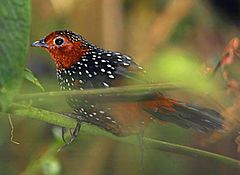Tapaculo facts for kids
Quick facts for kids Tapaculos |
|
|---|---|
 |
|
| Ocellated Tapaculo, Acropternis orthonyx | |
| Scientific classification | |
| Kingdom: | |
| Phylum: | |
| Class: | |
| Order: | |
| Suborder: | |
| Family: | |
The tapaculos (say ta-pa-COO-lo) are a group of small birds. They are a type of passeriform bird, which means they are perching birds. There are many different kinds, or species, of tapaculos. Most of them live in South America, especially in the Andean mountains. Three species, the Choco, the Pale-throated, and the Silvery-fronted Tapaculo, are found a bit further north in southern Central America.
Contents
What Are Tapaculos?
Tapaculos are small to medium-sized birds. They are usually between 10 and 25 centimeters (4 to 10 inches) long. Most tapaculos have dull colors like grey, brown, or black. Some might have a few white or reddish spots. They have strong legs and feet. This helps them move around on the ground. They also have a short tail that they often hold upright.
Where Do Tapaculos Live?
These birds love to live in thick forests. They prefer places with lots of undergrowth, which is like a dense bush layer. You can find them in misty cloud forests high in the mountains. They also live in humid lowland forests. They are very good at hiding. This makes them hard to spot in their natural homes.
Why Are They Called Tapaculos?
The name "tapaculo" comes from Spanish. It means "cover-rump" or "cover-bottom." This name probably comes from how they hold their short tails. They often hold them upright, almost as if covering their rear end. It might also refer to their habit of hiding in dense bushes.
Tapaculo Behavior
Tapaculos are known for their unique behaviors. They spend most of their time on or near the ground. They hop around quickly through the dense plants. They are quite shy and prefer to stay hidden.
What Do Tapaculos Eat?
These birds mainly eat insects. They search for bugs and other small creatures in the leaf litter on the forest floor. They might also eat some small seeds or berries. Their strong legs help them scratch through leaves to find food.
Tapaculo Sounds
Even though they are hard to see, you can often hear tapaculos. They have very loud and distinct calls. Each species has its own special song or call. Some calls sound like whistles, while others are like trills or chattering noises. These calls help them communicate with each other. They use them to find mates or warn others about danger.
Reproduction and Nesting
Tapaculos have interesting ways of building their nests. They are very creative about where they choose to lay their eggs.
Nesting Habits
Tapaculos build their nests in many different places. Some dig burrows in the ground. These burrows can be in soft soil or even old tree stumps. Other species might use holes in trees. Some tapaculos build a ball-shaped nest. They make these nests out of moss and other plant materials. They hide these ball nests deep inside a bush or a tangle of vines.
Life Cycle
Female tapaculos usually lay two to four eggs. Both parents help to incubate the eggs. This means they take turns sitting on them to keep them warm. After the chicks hatch, both parents also help to feed them. The young birds grow quickly. They soon leave the nest to start their own lives in the forest.
Images for kids
See also
 In Spanish: Rinocríptidos para niños
In Spanish: Rinocríptidos para niños


